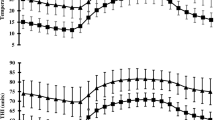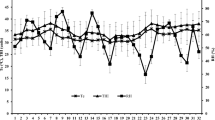Abstract
Free ferulic acid (FA) is a natural compound with antioxidant properties which mitigates the negative effects of cold stress in sheep; however, its impact on thermoregulatory responses in heat-stressed sheep has not been defined. The objective was to evaluate the effects of FA supplementation on physiological responses, serum analyte concentrations, and the hematological profile of heat-stressed hair ewe lambs. Twenty-two Dorper × Katahdin ewe lambs (initial body weight = 23.5 ± 2.8 kg and age = 4 months) were housed in individual pens for 40 days and assigned under a randomized complete block design to the following treatments (n = 11): basal diet with 0 (control) or 250 mg of FA/kg of feed. The FA × sampling day interaction only affected serum concentration of some metabolic hormones; particularly on day 20 of the trial, FA increased (P < 0.01) insulins and the insulin to glucose ratio while decreased (P = 0.05) thyroxine. Overall, supplemental FA did not affect rectal temperature, respiratory rate, most body surface temperatures, feedlot performance, and serum concentrations of metabolites, electrolytes, triiodothyronine, and cortisol. In addition, FA only tended to decrease (P ≥ 0.09) erythrocyte count and plaquetocrit and to increase (P = 0.08) mean corpuscular volume. In conclusion, FA supplementation did not improve the growth nor thermoregulatory capacity of heat-stressed hair ewe lambs. Still, it partially modulated the metabolism to reinforce some energetic adaptive mechanisms when the ambient temperature was ≥ 35 °C.


Similar content being viewed by others
Data availability
The datasets used and/or analyzed during the current study are available from the corresponding author on reasonable request.
References
Alhidary IA, Abdelrahman MM (2016) Effects of naringin supplementation on productive performance, antioxidant status and immune response in heat-stressed lambs. Small Rumin Res 138:31–36. https://doi.org/10.1016/j.smallrumres.2016.03.030
Al-Asadi FA, Habib HN, Hassan AF (2020) Effect of the injection of vitamins AD3E and the seasons on some blood traits, biochemical components and hormones of Arabi rams. J Anim Behav Biometeorol 8:142–151. https://doi.org/10.31893/jabb.20010
AOAC (1990) Official methods of analysis, 15th edn. Association of Official Analytical Chemists, Washington, DC
Baenyi SP, Birindwa AB, Mutwedu VB, Mugumaarhahama Y, Munga A, Mitima B, Kamgang VW, Ayagirwe BB (2020) Effects of coat color pattern and sex on physiological traits and heat tolerance of indigenous goats exposed to solar radiation. J Anim Behav Biometeorol 8:142–151. https://doi.org/10.31893/jabb.20017
Chauhan SS, Celi P, Fahri FT, Leury BJ, Dunshea FR (2014) Dietary antioxidants at supranutritional doses modulate skeletal muscle heat shock protein and inflammatory gene expression in sheep exposed to heat stress. J Anim Sci 92:4897–4908. https://doi.org/10.2527/jas.2014-8047
Chowdhury S, Ghosh S, Das AK, Sil PC (2019) Ferulic acid protects hyperglycemia-induced kidney damage by regulating oxidative insult, inflammation and autophagy. Front Pharmacol 10:1–24. https://doi.org/10.3389/fphar.2019.00027
Ellamie AM, Fouda WA, Ibrahim WM, Ramadan G (2020) Dietary supplementation of brown seaweed (Sargassum latifolium) alleviates the environmental heat stress-induced toxicity in male Barki sheep (Ovis aries). J Therm Biol 89. https://doi.org/10.1016/j.jtherbio.2020.102561
González-Ríos H, Gil Lozano DA, Berrondo Mir A (2013) Ferulic acid as feed supplement in beef cattle to promote the meat quality of the carcass and the meat. US 2013/0041036A1
INEGI (2017) Anuario estadístico y geográfico de Baja California 2017. https://www.datatur.sectur.gob.mx/ITxEF_Docs/BCN_ANUARIO_PDF.pdf. Accessed 1 Jun 2019
Ithurralde J, Bianchi G, Feed O, Nan F, Garibotto G, Bielli A (2015) Histochemical fiber types in 16 heavy-lamb skeletal muscles. Small Ruminant Res 125:88–92. https://doi.org/10.1016/j.smallrumres.2015.02.006
Jouda J, Alsamawi A, Qasim Ali L (2017) Effect of hyper- and hypothyroidism on many physiological parameters and the rate of some diseases. Karbala J Pharm Sci 8:70–78
Kumar N, Goel N (2019) Phenolic acids: natural versatile molecules with promising therapeutic applications. Biotechnol Reports 24:e00370. https://doi.org/10.1016/j.btre.2019.e00370
Kumar N, Pruthi V (2014) Potential applications of ferulic acid from natural sources. Biotechnol Reports 4:86–93. https://doi.org/10.1016/j.btre.2014.09.002
Littell RC, Henry PR, Ammerman CB (1998) Statistical analysis of repeated measures data using SAS procedures. J Anim Sci 76:1216–1231. https://doi.org/10.2527/1998.7641216x
Liu H, Li K, Mingbin L, Zhao J, Xiong B (2016) Effects of chestnut tannins on the meat quality, welfare, and antioxidant status of heat-stressed lambs. Meat Sci 116:236–242. https://doi.org/10.1016/j.meatsci.2016.02.024
Ma ZC, Hong Q, Wang YG, Tan HL, Xiao CR, Liang QD, Lu BB, Gao Y (2011) Effects of ferulic acid on hematopoietic cell recovery in whole-body gamma irradiated mice. Int J Radiat Biol 87:499–505. https://doi.org/10.3109/09553002.2011.548438
Macías-Cruz U, Gastélum MA, Avendaño-Reyes L, Correa-Calderón A, Mellado M, Chay-Canul A, Arechiga CF (2018b) Variations in the thermoregulatory responses of hair ewes during the summer months in a desert climate. Rev Mex Ciencias Pecu 9:738–753
Macías-Cruz U, Avendaño-Reyes L, Álvarez-Valenzuela FD, Torrentera-Olivera NG, Meza-Herrera C, Mellado-Bosque M, Correa-Calderón A (2013) Growth and carcass characteristics of ewe lambs treated with zilpaterol hydrochloride during spring and summer. Rev Mex Ciencias Pecu 4:1–12
Macías-Cruz U, López-Baca MA, Vicente R, Mejía A, Álvarez FD, Correa-Calderón A, Meza-Herrera CA, Mellado M, Guerra-Liera JE, Avendaño-Reyes L (2016) Effects of seasonal ambient heat stress (spring vs. summer) on physiological and metabolic variables in hair sheep located in an arid region. Int J Biometeorol 60:1279–1286. https://doi.org/10.1007/s00484-015-1123-6
Macías-Cruz U, Perard S, Vicente R, Álvarez FD, Torrentera-Olivera NG, González-Ríos H, Soto-Navarro SA, Rojo R, Meza-Herrera CA, Avendaño-Reyes L (2014) Effects of free ferulic acid on productive performance, blood metabolites, and carcass characteristics of feedlot finishing ewe lambs. J Anim Sci 92:5762–5768. https://doi.org/10.2527/jas2014-8208
Macías-Cruz U, Saavedra OR, Correa-Calderón A, Mellado M, Torrentera-Olivera NG, Chay-Canul A, López-Baca MA, Avendaño-Reyes L (2020) Feedlot growth, carcass characteristics and meat quality of hair breed male lambs exposed to seasonal heat stress (winter vs. summer) in an arid climate. Meat Sci 169:108202. https://doi.org/10.1016/j.meatsci.2020.108202
Macías-Cruz U, Vicente-Pérez R, López-Baca MA, González-Ríos H, Correa-Calderón A, Arechiga CF, Avendaño-Reyes L (2018a) Effects of dietary ferulic acid on reproductive function and metabolism of pre-pubertal hairbreed ewes during the anestrous season. Theriogenology 119:220–224. https://doi.org/10.1016/j.theriogenology.2018.07.012
Marai IFM, El-Darawany AA, Fadiel A, Abdel-Hafez MAM (2007) Physiological traits as affected by heat stress in sheep-a review. Small Rumin Res 71:1–12. https://doi.org/10.1016/j.smallrumres.2006.10.003
Naowaboot J, Piyabhan P, Tingpej P, Munkong N, Parklak W, Pannangpetch P (2018) Anti-insulin resistant effect of ferulic acid on high fat diet-induced obese mice. Asian Pac J Trop Biomed 8:604–608. https://doi.org/10.4103/2221-1691.248098
Nicolás-López P, Macías-Cruz U, Correa-Calderón A, Mellado-Bosque M, Díaz-Molina R, Avendaño-Reyes L (2021a) Ajustes asociados a la aclimatación y estrés oxidativo en ovinos bajo estrés calórico: una revisión. Inf Tec Econ Agrar. https://doi.org/10.12706/itea.2021a.005
Nicolás-López P, Macías-Cruz U, Mellado M, Correa-Calderón A, Meza-Herrera CA, Avendaño-Reyes L (2021b) Growth performance and changes in physiological, metabolic and hematological parameters due to outdoor heat stress in hair breed male lambs finished in feedlot. Int J Biometeorol 65:1451–1459. https://doi.org/10.1007/s00484-021-02116-x
Qaid MM, Abdelrahman MM (2016) Role of insulin and other related hormones in energy metabolism. A review. Cogent Food Agric 2. https://doi.org/10.1080/23311932.2016.1267691
Salazar-López N, Astiazarán-García H, González-Aguilar G, Loarca-Piña G, Ezquerra-Brauer JM, Domínguez-Avila J, Robles-Sánchez M (2017) Ferulic acid on glucose dysregulation, dyslipidemia, and inflammation in diet-induced obese rats: an integrated study. Nutrients 9:1–13. https://doi.org/10.3390/nu9070675
SAS (2004) Statistical Analysis SystemV. 9.0 forWindows. SAS Institute Inc., Cary, NC, USA
Schiaffino S, Reggiani C (2011) Fiber types in mammalian skeletal muscles. Physiol Rev 91:1447–1531. https://doi.org/10.1152/physrev.00031.2010
Simonides WS, van Hardeveld C (2008) Thyroid hormone as a determinant of metabolic and contractile phenotype of skeletal muscle. Thyroid 18:205–216. https://doi.org/10.1089/thy.2007.0256
Valadez-García KM, Avendaño-Reyes L, Díaz-Molina R, Mellado M, Meza-Herrera CA, Correa-Calderón A, Macías-Cruz U (2021) Free ferulic acid supplementation of heat-stressed hair ewe lambs: oxidative status, feedlot performance, carcass traits and meat quality. Meat Sci 173:1–9. https://doi.org/10.1016/j.meatsci.2020.108395
Van Soest PJ, Robertson JB, Lewis BA (1991) Methods for dietary fiber, neutral detergent fiber, and nonstarch polysaccharides in relation to animal nutrition. J Dairy Sci 74:3583–3597. https://doi.org/10.3168/jds.S0022-0302(91)78551-2
Vicente-Pérez R, Macías-Cruz U, Avendaño-Reyes L, Correa-Calderon A, López-Baca MA, Lara-Rivera AL (2020) Impacto del estrés por calor en la produción de ovinos de pelo. Revisión. Rev Mex Ciencias Pecu 11:205–222
Wang Y, Meng Z, Guo J, Wang W, Duan Y, Hao X, Wang R, An X, Qi J (2019a) Effect of wheat bran feruloyl oligosaccharides on the performance, blood metabolites, antioxidant status and rumen fermentation of lambs. Small Rumin Res 175:65–71. https://doi.org/10.1016/j.smallrumres.2019.04.006
Wang Y, Wang W, Meng Z, Duan Y, An X, Qi J (2019b) Dietary supplementation of ferulic acid improves performance and alleviates oxidative stress of lambs in a cold environment. Can J Anim Sci 1–31. https://doi.org/10.1111/j.1365-2958.2003.03935.x
Zhou J, Parker DC, White JP, Lim A, Huffman KM, Ho JP, Yen PM, Kraus WE (2019) Thyroid hormone status regulates skeletal muscle response to chronic motor nerve stimulation. Front Physiol 10:1–12. https://doi.org/10.3389/fphys.2019.01363
Acknowledgements
This article is part of the research project of the first author, who thanks CONACYT-México for the scholarship granted to carry out his doctoral studies. The authors also appreciate the technique support provided in the field and laboratory phase to Karen M. Valadez, Arnulfo Vicente, Marco A. Contreras, and Oscar R. Saavedra.
Funding
This work was supported by the Universidad Autónoma de Baja California within the “21a. Internal Call of Support for Research Projects (Program number: 2237).”
Author information
Authors and Affiliations
Contributions
Ulises Macías-Cruz and Leonel Avendaño-Reyes were responsible for the conception, design, and obtaining financing for the research, as well as providing support in writing the manuscript. Porfirio Nicolás-López, Karen M. Valadez-García, and Ricardo Vicente-Pérez conducted the experimental fieldwork, organized the data, and wrote the first manuscript proposal. Raúl Díaz-Molina and Carlos Luna helped to the laboratory analysis and interpretation of results, while Miguel Mellado, Cesar Meza-Herrera, and Vielka Castañeda Bustos in the statistical analysis and manuscript revision. In general, all authors reviewed the final version of the manuscript and approved it.
Corresponding author
Ethics declarations
Ethics approval and consent to participate
All handling procedures applied to animals followed guidelines established in the Mexican Official Standard NOM-062-ZOO-1999, which indicates the technical specifications for the production, care, and use of laboratory animals. Likewise, the Animal Care Committee of the UABC approved and supervised all experimental procedures.
Consent for publication
Not applicable.
Competing interests
The authors declare no competing interests.
Additional information
Responsible Editor: Mohamed M. Abdel-Daim
Publisher's note
Springer Nature remains neutral with regard to jurisdictional claims in published maps and institutional affiliations.
Rights and permissions
Springer Nature or its licensor holds exclusive rights to this article under a publishing agreement with the author(s) or other rightsholder(s); author self-archiving of the accepted manuscript version of this article is solely governed by the terms of such publishing agreement and applicable law.
About this article
Cite this article
Nicolás-López, P., Macías-Cruz, U., Avendaño-Reyes, L. et al. Ferulic acid supplementation for 40 days in hair ewe lambs experiencing seasonal heat stress: short-term effects on physiological responses, growth, metabolism, and hematological profile. Environ Sci Pollut Res 30, 11562–11571 (2023). https://doi.org/10.1007/s11356-022-22962-5
Received:
Accepted:
Published:
Issue Date:
DOI: https://doi.org/10.1007/s11356-022-22962-5




